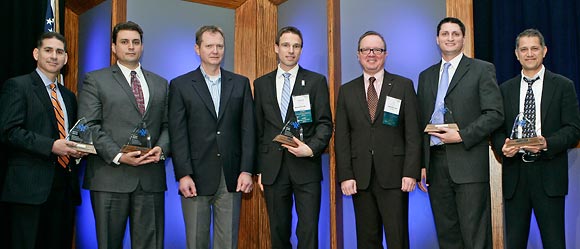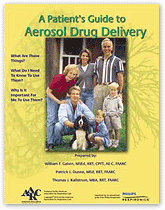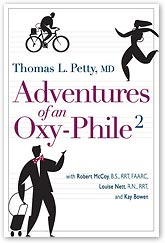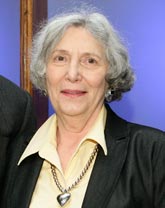Respiratory Care 2010
56th AARC International Respiratory Congress
Monday through Thursday, December 6—9, 2010
The Las Vegas Convention Center, Las Vegas, NV

Congress Gazette
Tuesday, December 7
Top Companies Honored with Zenith Awards

This year’s Zenith Awards went to CareFusion, Covidien, Dräger, Kimberly-Clark, and Masimo.
Leadership Institute Making Progress

Toni Rodriguez
The AARC’s new Leadership Institute is an interactive, online learning program that will eventually provide respiratory therapists with a means by which to earn a certificate of completion in one or more of three specialty tracks—management, education, and research. Program developers will bring Congress attendees up-to-speed on this exciting new opportunity from the AARC during a symposium on “The AARC Leadership Institute: Preparing Tomorrow’s Leaders Today” taking place this afternoon.
As attendees will learn during the session, the Institute will begin with a core curriculum common to all three tracks. A request for proposals went out for the first five courses this fall, and development of the Introduction to Human Communication, Health Information Management and Informatics, Financial Planning and Budgeting Principles, Small Group Problem Solving and Decision Making, and Basic Management Skills courses is expected to begin sometime next fall.
“The Institute will be designed to provide respiratory therapists with the leadership skills they need to succeed on the job, and the online format will ensure the curriculum is accessible to anyone who would like to take advantage of it,” says Steering Committee Chair Toni L. Rodriguez, EdD, RRT. Dr. Rodriguez is joined on the committee by Robert L. Chatburn, RRT-NPS, FAARC; Richard M. Ford, RRT, FAARC; Timothy Myers, BSRT, RRT-NPS; Linda Van Scoder, EdD, RRT, FAARC; and Sam Giordano, MBA, RRT, FAARC.
Thanks to Everyone Who Participated in Drive4COPD

The Drive4COPD campaign began earlier this year with the lofty goal of screening one million people for COPD using a simple, five question population screener. As a key partner in the effort, the AARC turned to all of you for help.
We’re happy to report you rose to the occasion! Working with your state societies you have screened thousands of people over the past several months, helping to ensure more people with signs and symptoms of COPD will get into their physicians’ offices and get checked out to see if they may have this chronic lung condition.
And congratulations to the West Virginia and Pennsylvania Societies for coming out on top in our friendly competition to see who could screen the most people! They were recognized for their effort during yesterday’s Awards Ceremony.
President’s Report
Timothy Myers, BS, RRT-NPS

Timothy Myers
Editor’s Note: The following is a synopsis of the report Timothy Myers, BS, RRT-NPS, presented the during the Annual Business Meeting that took place this morning.
As I embark upon the final hours of my 2-year presidency for the AARC, I am grateful for the opportunity and experience it has brought me both personally and professionally. I have been honored and proud to represent one of the most vibrant and energetic professions during a time of sustained growth and international expansion. I hope with this final presidency report, you will concur that as an Association we have been extremely busy, financially efficient, and clinically effective over the past 2 years. I want to thank you one final time for the rewarding opportunity to serve as your president. The time has passed by quickly, but it has been a memorable couple of years with much accomplished by the Association and its members.
Membership
As a professional association, one of our primary goals and financial staples is to increase our membership. Since December of 2008, our membership has climbed 4.5% and now stands at 52,000 strong. That membership rate is at an all-time high and continues to steadily increase despite a sagging economy. We have also witnessed the advent of a professional networking tool in AARConnect that will serve as a member benefit to extend our pursuit of professional excellence and advance the science and profession of respiratory care. This is just one small example of the value of the AARC membership.
International presence
Our international presence continues to expand globally through international speaking engagements, increasing international membership, foreign translations of our educational resources and podcasts, an increasing number of foreign submissions to RESPIRATORY CARE, and re-publication of our journal articles in foreign publications. Last September, we added our third international affiliate to the AARC with the United Arab Emirates joining Mexico and Turkey. Based on a recent application submission, we expect a possible fourth — Saudi Arabia — to be added during this International Congress.
Access to respiratory therapists is critical
Universal support of the Medicare Respiratory Therapy Initiative (H.R. 1077 and S. 343) by a united respiratory care profession would serve as a major launching pad to revise the Medicare program to permit qualified RTs to provide a variety of respiratory therapy services in outpatient settings without the physician having to physically be present. When this legislation is enacted, a new day will dawn on patient access to RTs.
We have continued to network with vested partners, affiliated organizations, patient advocacy groups, and local, state, and federal governments to ensure and maintain the integrity and the scope of practice of respiratory therapists across the continuum of care when it pertains to the treatment and care of patients with cardiopulmonary disease.
Respiratory Care in 2015 and Beyond
The goal of the 2015 Conferences was to identify the knowledge, skills, and attributes of respiratory therapists in the year 2015 and beyond as well as to suggest the elements of education, training, and competency documentation that will be needed to assure safe and effective executions of those roles and responsibilities. All 3 conferences have offered critical ideals, insights and thoughts on moving the profession forward. It will now be critical to take the key findings and ideals from these conferences and investigate the feasibility of implementation based on documented needs of our patients and the changing health care landscape.
AARC Leadership Institute
The Leadership Institute will be the first comprehensive AARC program designed to provide advanced training to guarantee the future stability of management, research, and education leadership within the profession of respiratory care. The Leadership Institute will start with a series of core courses designed to establish the basic foundation for all 3 distinct areas of career focus for the Institute’s participants. We expect this Web-based curriculum to begin being introduced late in 2011.
Access to quality continuing education
A key principle of the 1946 chartered Inhalation Therapy Association was “To advance the knowledge of Inhalation Therapy through institutes, lectures, and other means….” AARC’s major emphasis has been and will always remain the same: post-graduate education of a variety of professions taking care of patients with cardiopulmonary diseases. The AARC’s mission is in helping you grow and develop as a respiratory care professional through a variety of multimedia and live programs and projects that meet your educational needs.
Concluding remarks
A stagnant economy and a changing health care landscape present us with many unknowns and challenges over the next decade. There is one thing that I am certain about despite all this uncertainty; the profession of respiratory care has always accepted today’s challenges as tomorrow’s opportunities. With your active participation and dedication to professional excellence, advocacy, and the art and science of respiratory care, we will accomplish great things for our patients and set the tone for those who will enter into the profession and be our future. In conclusion, I would like to thank the AARC membership for providing me the opportunity to serve as your 2009–2010 president. It has been a shear delight working with a group of excellent leaders within the state societies, the AARC Board of Directors, House of Delegates, and especially the AARC’s executive office staff over the past 2 years. While my term as AARC president has come to an end, I look forward to working with our next president, Karen Stewart, in continuing to advance the cause of our patients, their families, the public, the profession, and the respiratory therapist into the future.
Secretary-Treasurer’s Report
by Linda Van Scoder, EdD, RRT, FAARC

Linda Van Scoder
Editor’s Note: The following is a synopsis of the report Linda Van Scoder presented during the Annual Business Meeting that took place this morning.
The U.S. economy remains sluggish, but there has been improvement. Because we entered the crisis in such a strong financial position, the AARC remains financially sound. Although non-dues related revenue is not yet where we would like it to be, it has shown signs of improvement during the second half of 2010. The AARC is committed to keeping your dues at one of the lowest levels among health professional organizations, so we will continue to identify other opportunities to assure our growth going forward.
The AARC remains strong because of its members, and our membership continues to increase. Because of the valuable support of you and your colleagues, our membership was 50,420 in September of this year. Having our membership top 50,000 is a major accomplishment, and with a strong fall we should be even higher by the end of the year.
To meet your professional demands, the AARC continues to focus on education with the development of the online Leadership Institute and will continue to develop other attractive educational opportunities. Professor’s Rounds and webcasts continue to be popular offerings.
These programs are being offered because you want to be the best. You keep asking for quality products, peer-reviewed literature, and educational offerings by experts, and the AARC continues to meet your demands.
Thank you for the opportunity to serve you this year as your secretary/treasurer, and thanks to each and every one of you for making this year so successful for the AARC in spite of the challenges we face.
Lecture Lab Testing Out New Speakers
The AARC Congress is a great place to hear lecturers present the latest on respiratory care—but it’s also a place to see if you have what it takes to become one of those lecturers in the future. Thanks to our Lecture Lab, people interested in speaking at the 2011 Congress in Tampa, FL, are getting a chance to “try out” this week in Las Vegas.
Think you’d like to try your hand at public speaking too? Then watch for announcements about next year’s Lecture Lab on www.AARC.org.
Two New Books Target Aerosol Delivery Devices

Respiratory therapists are the experts on aerosol medication delivery devices, but we all know our colleagues in other disciplines, and patients and families themselves, often administer medications from these devices as well.
Thanks to the AARC, all of these folks are going to have more information at their fingertips to ensure they are operating them correctly. Our “A Patient’s Guide to Aerosol Drug Delivery,” by William F. Galvin, MSEd, RRT, FAARC, and Patrick Dunne, MEd, RRT, FAARC, is out now and provides patients with step-by-step guidance on how to take their medications and care for their devices.
The new guide will get a good test run at the Congress, as volunteers hand out copies during the annual Your Lung Health program taking place on Thursday at a local mall.
“A Guide to Aerosol Delivery Devices for Physicians, Nurses, and Pharmacists,” by Deborah Elliott, MSN, NP-C, is designed to bring these professionals up-to-speed on the latest in aerosol drug delivery so they can ensure their patients receive the information they need to manage their conditions. The guide is in the final editing stages and should be published soon. Visit AARC.org to learn more about these great publications.
New Book a Labor of Love

When Thomas L Petty, MD, FAARC, passed away last December, he was in the middle of editing a sequel to his popular “Adventures of an Oxy-Phile,” a book he wrote for people living with supplemental oxygen.
After his death, his long-time associate, Louise Nett, RN, RRT, FAARC—who received the newly renamed Thomas L. Petty, MD Invacare Award for Excellence in Home Respiratory Care at the Awards Ceremony yesterday morning—decided the best way to honor his memory would be to finish what he had started. “Adventures of an Oxy-Phile 2” was published earlier this year and is already garnering rave reviews. In the following interview, Nett explains what went into the book and why.
Gazette: “Adventures of an Oxy-Phile 2” is a sequel to Dr. Petty’s first book on oxygen users, “Adventures of an Oxy-phile.” Why do you think he decided to do another book, and what were his hopes for the publication?
Louise Nett: Dr. Petty wanted to do another Oxy-phile book because he thought there was a lot of new information that oxygen patients would like to know about. The advances in personal oxygen concentrators powered by newer battery technology would be of interest to many. The renewed interest in transtracheal oxygen is another.
Tom was a believer that all patients on oxygen should have a personal oximeter. All the patients know that to be true for themselves and are users. He also wanted the patients to expand their stories of life as an oxyphile. We think they did a good job of telling it like they live life.
Dr. Vlady Rozenbaum explains some of the challenges of international travel with oxygen. It is possible to do, but one must plan ahead. Edna Fiore, a patient advocate, works tirelessly to represent COPD patients at meetings—especially at national meetings, conferences, and in Washington, DC. I think that almost all patients will identify with the chapter by Dr. Gene Schwarz titled, “Living with COPD.” He is an accomplished writer and has authored two fiction books.
Lynn Cole, Mike McBride, and Mark Junge break the mold telling their stories of adventuring forth with their trusty oxygen supply. Their stories of marathons, mini marathons, ALA 47 flight stair climbs, and biking across the United States while on oxygen are more than what most “normal” people will ever be able to tell.
Linda Watson, the current president of EFFORTS (Emphysema Foundation for Our Right to Survive), was first diagnosed with emphysema at age 38. Her struggle to find information has made her a patient advocate. Canadian Chris Wigley learned the value of rehabilitation, not from pulmonary rehab but because he had a cardiac condition. He soon learned about the value of oxygen in his exercise program.
Respiratory therapists will recognize their peers Bob McCoy, John Goodman, and Mark Mangus as proponents of patient education. They believe a knowledgeable patient is the best member of the health team. Mary Burns, famous for her work with patient support groups and pulmonary rehab, talks about her work in California, including their mission to establish that oxygen-using patients are safe travelers on cruises.
The chapters from friends Dr. Jan Zielinski from Poland, Dr. Italo Brambilla from Italy, and Kozui Kida, from Japan will let U.S. and Canadian patients know that oxygen therapy is now an international therapy as well.
Some parts of the first Oxy-phile book that Dr. Tom wrote are included in this book. He also writes about his need for oxygen therapy due to four heart surgeries. Dr. Rich Casaburi writes about the need for new research in long-term oxygen therapy.
Gazette: Dr. Petty passed away before being able to finish the book. Why did you and your colleagues decide to take on the project and bring it to fruition?

Louise Nett
Louise Nett: We knew we had to finish the book because so many people had invested energy and time to write their chapters. And many people had heard about the book and were looking forward to seeing more information for patients receiving oxygen therapy. We felt we had to complete what Dr. Petty started because he always worked as a team leader. When the team leader can’t finish the job, the rest take over.
Gazette: The book features real oxygen users who share their stories—some of them quite amazing—about living well despite the need for supplemental oxygen. How did you recruit them to write chapters for the book, and what was their reaction to sharing their stories in this fashion?
Louise Nett: Dr. Petty had talked or written to all the authors in early fall of 2009. To a person they were enthusiastic about being part of this book. Some of the authors were well known in patient circles for their contributions. Dr. Petty knew many of the authors on a personal level and some through communication with them by e-mail.
Gazette: The authors talk about everything from what daily life is like on oxygen to how they’ve accomplished feats like completing the Boston Marathon. What do you think these stories say about supplemental oxygen users and what they are able to accomplish?
Louise Nett: These stories tell of patients overcoming their emotions when learning of the need for oxygen. Instead of feeling sorry for themselves, they decided to make the best of a tough situation. First they learned as much as they could from books, the Internet, and health care providers. They then looked into pulmonary rehab programs and adopted all the advice of the group leader or other patients. They found that exercise was beneficial to their condition. The more they exercised, the better they felt. With the support of their loved ones and friends, they started a new life.
And that is what supplemental oxygen can do—give new life. They began to take charge of their lives and their disease. It did not control them; they became the controller. They learned about their medications and became the most important member of their health team.
We can all learn something from these patients who overcame adversity and are living new lives as oxy-philes. They will all say that walking marathons, stair climbing, or biking across the United States are definitely not for everyone. They know they are unusual, but they say everyone can do a little more. They encourage other patients to make an effort to move—walk a little today, walk a little more tomorrow, and then keep it up until you get to the level you are satisfied with.
Gazette: How do you believe the book can help both oxygen users and the clinicians who care for them better understand oxygen therapy and what people can accomplish despite using it?
Louise Nett: The book is written for patients, but their health care providers will learn a lot about the ability of a determined patient. Oxygen is not a hindrance unless one lets it be so. For individuals with a focus on living life to the fullest, this book will be an inspiration. The patient authors have contributed so much to our knowledge of what is possible on oxygen.
Gazette: What do you think Dr. Petty would say about “Adventures of an Oxy-Phile 2” if he were here to see it today?
Louise Nett: He would say that is what we were supposed to do—i.e., finish the book. Tom was a dedicated worker all his life. He always said, “finish what you start.” Since he couldn’t finish the book, it fell to us, his friends, to complete the project. I am sure he is looking down and thanking all who participated in the book. And he continues to inspire us to learn more about this magnificent drug. He is pushing us to tell others about this book so that it can be an inspiration to others who feel devastated by the knowledge that they need oxygen. Oxygen can be the beginning of the first day of the rest of their lives.
Gazette: You received the Thomas L. Petty, MD Invacare Award for Excellence in Home Respiratory Care during the Awards Ceremony on Monday. What did you think about winning the first of this award to be renamed for Dr. Petty?
Louise Nett: I was pleased to hear about the Thomas L. Petty, MD Invacare Award for Excellence in Home Respiratory Care this summer. However, I was shocked to hear I was the recipient. It is quite amazing that work done in the 1960s and early 1970s is being remembered today.
The award really should go to all the early pioneers in home care. I am just one of the people who advocated for getting people out of the hospital and into their homes. Rehabilitation was the key, and oxygen was a significant tool in home care. Tom Petty and I learned a lot about home care from our friends, Drs. Alvin Barach, from New York, and Rueben Cherniak, then in Winnipeg, Canada. We looked to them for ideas and help as we established our program of care. We are all benefiting from their pioneering work in home care.
We had a lot of fun in the early days making home visits all over the greater Denver area. The patients taught us so much. They are the ones who really deserve the award. I am thankful for this honor. I know Tom would be pleased to learn that his memory is preserved in this home care award.
Ordering information for “Adventures of an Oxy-Phile 2” is available on www.drtompetty.org.
Congress Tweets
Add #aarc10 to your tweets to be heard